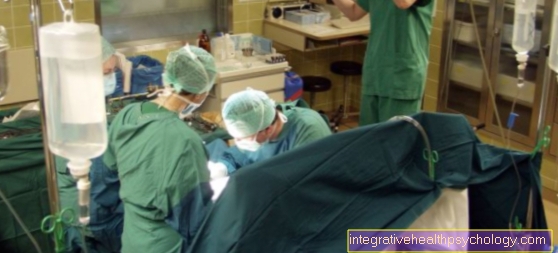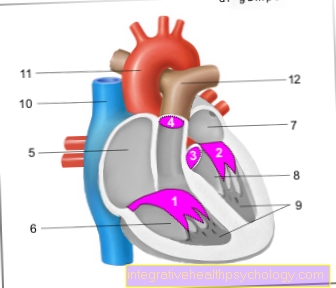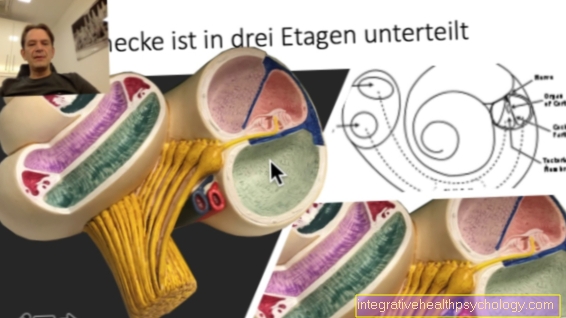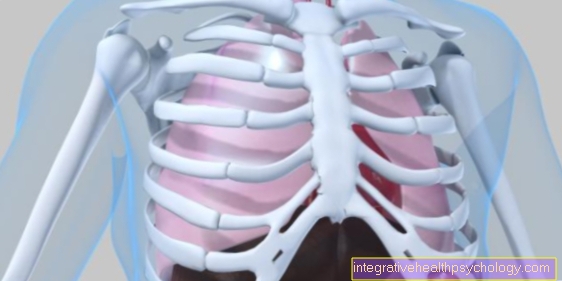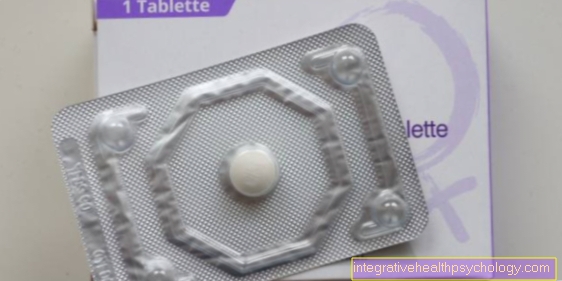Toe amputation
introduction
A toe amputation is the surgical removal of one or more toes.
A toe amputation is recommended if the tissue is damaged by illness or an injury to such an extent that there is no longer any prospect of the toe being able to heal again. Otherwise, the toes can rot and become inflamed, which in the worst case could lead to life-threatening blood poisoning.

causes
The causes that lead to the need for a toe amputation are usually diseases in which the supply of nutrients to the tissue is disturbed. An amputation becomes necessary when the toe can no longer be preserved and would otherwise die.
The most common cause is the underlying disease diabetes mellitus (“diabetes”). In particular, if the disease is not adequately treated, it develops over time Destruction of the small blood vessels and nerves, so that the toes as the last section of the foot are no longer adequately supplied with nutrients.
For more information on this destruction of small blood vessels and nerves, see our article Diabetic microangiopathy.
Another common cause that can lead to a toe amputation is the so-called “intermittent claudication” (peripheral arterial occlusive disease; PAD). This disease, which is mainly caused by smoking and high blood pressure, leads to increasing calcification of the blood vessels in the arms and legs. At some point, not enough blood, and thus oxygen and nutrients, no longer reaches the toes, so that these too die if they are not amputated.
The causes of this occlusive disease can be found in our article PAD - These are the causes!
With both of these causes, other parts of the foot or lower leg are often affected and more radical operations must be performed. In contrast to the chronic diseases mentioned, an accident or other injury to one or more toes may occasionally make a toe amputation necessary.
L.Do you suffer from a wound on your foot that does not heal? You can find more information about this in our articles Wound healing disorder and Inflammation of the wound!
The diabetic foot as the cause of a toe amputation
Occasionally, a diabetic foot may require one or more toes to be amputated. However, one only decides to have an amputation if all other treatment measures are insufficient to preserve the toe or toes.
The most important measure to prevent the development of a diabetic foot and the need for amputation is to treat the condition as best you can. In addition to a healthy diet and physical activity, drug treatment and regular medical examinations are important. If a diabetic foot with open wounds occurs, these must be treated professionally as best possible.
Only when there is no prospect of a cure does one or more toes have to be amputated.
Do you have diabetes? The best way to manage your diabetes can be found in the following articles:
- Therapy of diabetes
- Dietary recommendations for diabetes
diagnosis
The diagnosis of a disease that requires a toe amputation is made by the doctor on the basis of various examinations. An amputation is usually only considered if there is irreversible tissue damage and the toe cannot be preserved. This can be the case, for example, due to insufficient blood flow as a result of vascular calcification or a non-healing wound.
In addition to the medical consultation and the physical examination, the doctor uses, for example, a vascular representation of the blood vessels using imaging methods such as angiography for the diagnosis.
Concomitant symptoms
Before the amputation
The possible accompanying symptoms that can occur if a toe amputation is necessary depend primarily on the underlying disease.
In the case of a diabetic foot, the pain-mediating nerve fibers are often damaged or destroyed, so that, in spite of pronounced tissue damage or inflammation in the toe (s), there is often little or no pain. Many patients, on the other hand, tend to complain of a tingling sensation like “pins and needles” or a feeling of numbness in the feet. In addition, restricted movement of the foot can be an accompanying symptom.
If hardening of the arteries, as in "intermittent claudication", PAD (peripheral arterial occlusive disease) is the underlying condition, on the other hand, pain is often in the foreground.
However, there is often a mixed picture of the diseases, so that the accompanying symptoms can be very different.
After the amputation
Toe amputation takes place under anesthesia so that no pain is felt. After the amputation, pain from the surgical procedure may persist, but this can usually be treated with painkillers. If the tissue heals without complications, the pain usually subsides within a few days.
In very rare cases, phantom pain occurs after weeks to months, which means that pain is felt in the toes that are no longer there.
In addition, the underlying disease that made the toe amputation necessary often progresses. After an initial improvement, pain in the rest of the foot may recur. In any case, recurring or worsening pain in the feet should be promptly clarified by a medical examination and assessment.
You may also be interested in this topic: Lower leg amputation
Course of the operation
preparation
Before performing a toe amputation, the doctor must explain the procedure and the risks of the procedure to the patient. In addition, blood must be drawn, for example to examine the patient's blood clotting.
Anesthesia is initiated before the actual procedure. In some cases, general anesthesia is used and in others only a local nerve block under twilight sleep conditions (sedation).
You can find more information about the process, risks and side effects of general anesthesia in our article: general anesthetic
execution
For the procedure, the patient lies supine on the operating table.
A longitudinal incision is made on the dorsum of the foot in the course of the toe that is to be amputated, in the area of the joint between the metatarsal bone and the toe. The cut is continued along the bone around the toe, leaving a small flap of skin on the sole of the foot.
The metatarsophalangeal joint is then exposed by severing the joint capsule and the ligaments. Particular care is taken to protect the articular cartilage of the metatarsal head. Finally, the flexor and extensor tendon are severed and the toe can be removed. With the help of the cut-out skin flap, the resulting hole can then be sutured.
More information about the amputation process:
- Amputation level
- Amputation technique
Aftercare
A simple toe amputation usually does not require any special follow-up care. Partial weight bearing on the foot is possible soon after the procedure.
Full weight bearing is possible as soon as the wound has healed. The treating surgeon will determine from which day exactly a partial or full load should take place and inform the patient.
It may be necessary to see the surgeon or family doctor again to check the wound or pull the stitches. The attending physician will also inform the patient of this and write it down in the discharge letter.
Orthopedic care, for example using special shoes or insoles, is not usually required. In individual cases this will also be communicated by the doctor. Furthermore, as after any surgical procedure, follow-up care includes the patient presenting to the doctor again in the event of symptoms such as pain or inflammation of the wound.
How you can accelerate wound healing and other interesting information can be found in our article about Wound healing!
Length of hospital stay
How long you are in hospital due to a toe amputation depends on the one hand on the general condition and the accompanying illnesses of the patient and on the other hand on the healing process.
A person with minor health problems is usually only in the hospital for a few days, provided that no complications arise.
However, if a wound healing disorder or an infection occurs during the stay, the length of time you have to stay in the hospital can be significantly extended. Depending on the condition and course, discharge can only take place after several weeks.
However, since a toe amputation is a comparatively minor amputation, complications are significantly less likely than with a larger amputation.
Duration of healing
No general statement can be made about the duration of healing after a toe amputation.
In the best case, after a complication-free course, the residual limb heals completely within a few weeks.
Often, however, a toe amputation is based on a disease in which blood flow and wound healing are restricted, such as diabetes mellitus (“diabetes”).
Since the disease is often progressive, other parts of the foot, such as the entire forefoot, may have to be amputated later. If an amputation of the foot becomes necessary, the doctor will decide, depending on the state of health of the foot, for an amputation that extends as far as necessary but as little as possible.
The toe amputation is the least extensive amputation. The disadvantage of this very cautious approach is that healing is delayed after the amputation and it can take several months for the wound to heal completely.
Degree of disability
When determining the degree of disability, the individual limitations of a person are always decisive.
- If a toe is amputated and the healing process is uncomplicated, there are usually no relevant restrictions, so that the procedure does not usually result in any disability.
- There is an exception if the big toe has to be amputated, as this is important for the stability of the foot and thus a safe stance and gait. If a big toe is lost, a degree of disability of 10% is usually recognized.
- If all toes of a foot are lost, a degree of disability of 20% is determined.
- If, in extreme cases, all toes of both feet have to be amputated, the result is a degree of disability of 30%.









